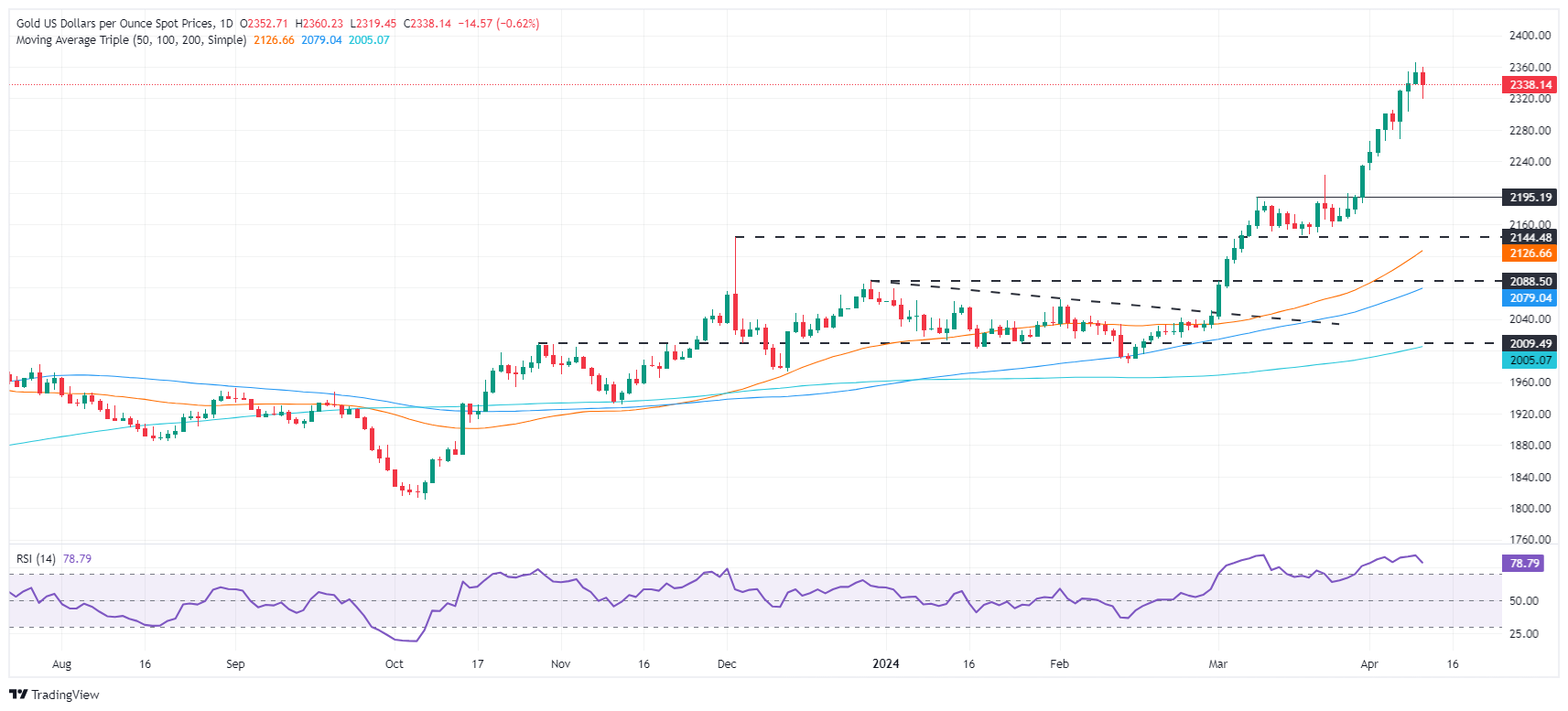- Gold drops as US inflation data complicates Fed rate cut intentions.
- Investors rethink Fed’s monetary approach amid persistent inflation as they now expect two rate cuts in 2024.
- US real yields rise above 2%, challenging Gold post-CPI release.
Gold price is on the defensive on Wednesday following the release of March inflation figures in the United States (US). The figures witnessed an uptick in monthly and annual readings and might dent the Federal Reserve’s (Fed) intentions of easing policy. Following the data release, US Treasury yields rose, the Greenback climbed, and US real yields overcame the 2% threshold, a headwind for the precious metal.
XAU/USD spot trades at $2,336 after losing 0.66% following the US Consumer Price Index (CPI) release. The US Bureau of Labor Statistics (BLS) announced that March’s CPI was hotter than expected, though unchanged in three of the four inflation readings compared to February’s data. Meanwhile, headline inflation jumped above the annual forecast and the prior month’s reading.
Daily digest market movers: Gold loses its shine after hot US CPI report
- US Consumer Price Index (CPI) increased 0.4% monthly and 3.5% annually, surpassing expectations and marking an uptick from the previous month’s figures.
- Core CPI, which excludes food and energy, also exceeded forecasts, remaining steady at 0.4% MoM and 3.8% YoY, mirroring February’s data.
- Following this, US Treasury bond yields experienced a significant surge, particularly at the short end, with the 2-year Treasury note yield jumping by 20 basis points.
- The US Dollar Index (DXY) also witnessed a substantial increase, soaring over 1% to reach new YTD high of 105.27.
- Data from the Chicago Board of Trade (CBOT) suggests that futures traders expect just two cuts to the fed funds rate as they project the main reference rate to end the year at 4.98%.
- World Gold Consortium reveals that the People’s Bank of China was the largest buyer of the yellow metal in February, increasing its reserves by 12 tonnes to 2,257 tonnes.
Technical analysis: Gold’s advance stalls, prices tumble below $2,350
Gold’s retreat from all-time highs opened the door to form an Evening Star candlestick pattern. However, XAU/USD must close below the April 8 open of $2,329, which would pave the way for a deeper correction.
The XAU/USD first support would be the April 8 daily low of $2,303. Once surpassed, that could put downward pressure on the yellow metal and drive it to March’s 21-session high of $2,222. Further losses are seen at $2,200.
On the other hand, if XAU/USD resumes its rally, buyers are eyeing the $2,350 mark, followed by $2,400.
Gold FAQs
Gold has played a key role in human’s history as it has been widely used as a store of value and medium of exchange. Currently, apart from its shine and usage for jewelry, the precious metal is widely seen as a safe-haven asset, meaning that it is considered a good investment during turbulent times. Gold is also widely seen as a hedge against inflation and against depreciating currencies as it doesn’t rely on any specific issuer or government.
Central banks are the biggest Gold holders. In their aim to support their currencies in turbulent times, central banks tend to diversify their reserves and buy Gold to improve the perceived strength of the economy and the currency. High Gold reserves can be a source of trust for a country’s solvency. Central banks added 1,136 tonnes of Gold worth around $70 billion to their reserves in 2022, according to data from the World Gold Council. This is the highest yearly purchase since records began. Central banks from emerging economies such as China, India and Turkey are quickly increasing their Gold reserves.
Gold has an inverse correlation with the US Dollar and US Treasuries, which are both major reserve and safe-haven assets. When the Dollar depreciates, Gold tends to rise, enabling investors and central banks to diversify their assets in turbulent times. Gold is also inversely correlated with risk assets. A rally in the stock market tends to weaken Gold price, while sell-offs in riskier markets tend to favor the precious metal.
The price can move due to a wide range of factors. Geopolitical instability or fears of a deep recession can quickly make Gold price escalate due to its safe-haven status. As a yield-less asset, Gold tends to rise with lower interest rates, while higher cost of money usually weighs down on the yellow metal. Still, most moves depend on how the US Dollar (USD) behaves as the asset is priced in dollars (XAU/USD). A strong Dollar tends to keep the price of Gold controlled, whereas a weaker Dollar is likely to push Gold prices up.

